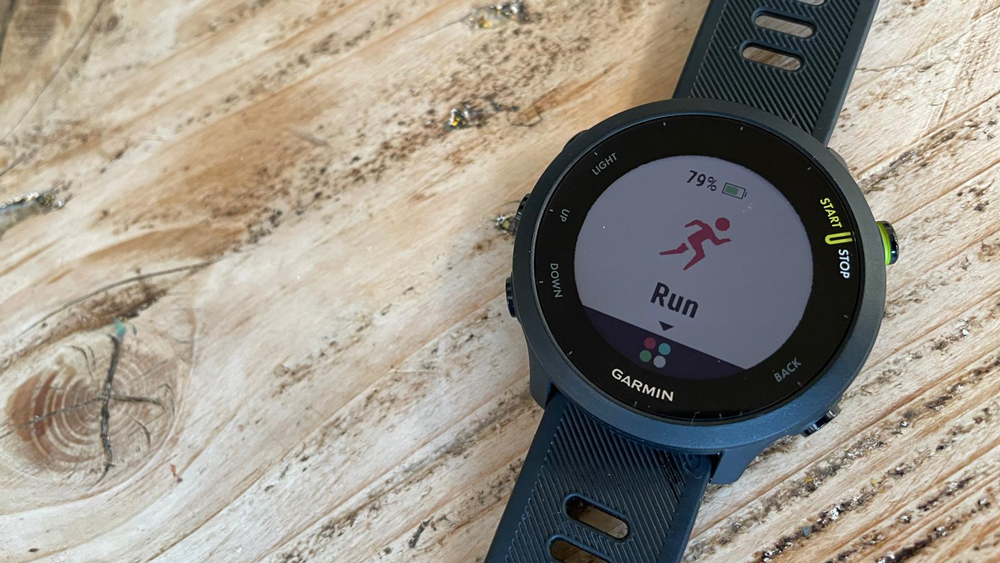Our Verdict
The Forerunner 55 has all the fundamental features a runner needs, and the suggested workouts and guided training plans make it great for beginners in particular.
For
- Comfortable, light design
- Suggested workouts
- Good battery life
Against
- No navigation features
- Limited training analysis
- No music storage
You can trust Coach
For a while now, the entry-level Garmin Forerunner watch has invariably been the best budget running watch. That was certainly true when the Forerunner 35 and 45 launched.
However, the new Forerunner 55 faces stiff competition at £180, the same price as the impressive Coros Pace 2. To set this generation apart, Garmin has added several features from its more advanced running watches and increased the battery life from 13 hours of GPS to 20. It’s not enough to see off the competition decisively but the Forerunner 55 is still a very good watch, and the new features are certainly welcome.
New Features On The Garmin Forerunner 55
The Forerunner 55 offers race predictions and recovery advice after your training sessions. These were not on the Forerunner 45, though they were on the 45 Plus, a slightly odd in-between launch that was sold only through Argos and the Garmin website.
One completely new feature to Garmin’s entry-level Forerunner is suggested workouts, which gives you a daily suggested run based on your recent training load. Thing is, you can’t actually see this training load or any analysis of it, as you can on Garmin’s more expensive watches. The suggested workouts are still helpful though, especially for newer runners.
Recent updates
December 1, 2023: There are now regular sales and deals featuring the Garmin Forerunner 55. In our extensive coverage of the best Black Friday Garmin deals in 2023 the best prices we tracked were $169.99 and £119.28. Our deal tracking of Amazon Prime Day Garmin deals in 2023 revealed a best price of £119.99.
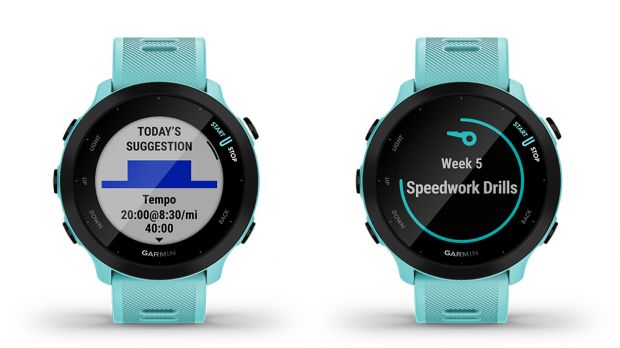
With Garmin Coach you can set up training plans for 5K, 10K and half marathon events to follow on the watch. If you’re not sure how to structure your running, the training plans and suggested workouts can take care of it for you, and while they’re not flawless – I’ve found the workout suggestions a little odd at times – you will get fitter and faster just by blindly following Garmin’s advice, and develop a good sense of the types of run you should use in your training.
Garmin’s Track Run sports mode also arrives on the Forerunner 55, which provides more accurate distance and pacing information when running on a 400m athletics track. Another is the Virtual Run mode, where you can use your watch to control an avatar in a training app like Zwift when running on a treadmill – though this relies on accurate pace detection from the watch, which I’ve found often differs quite a bit from the stats on the treadmill itself. There’s also a HIIT sports mode and a cadence alert that you can set up to help keep you at a certain cadence when running.
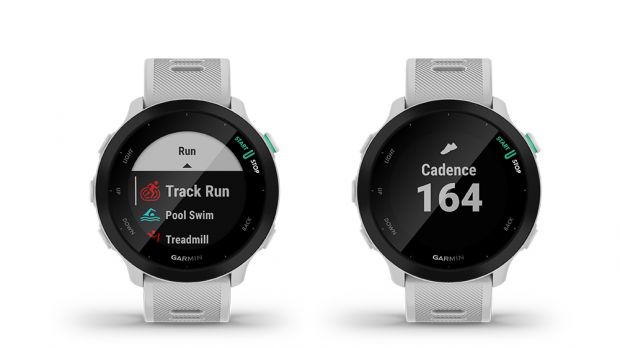
There are also two new racing features that have come to the watch from more advanced Garmin running watches. One is PacePro, a feature I really like, which can help you pace your events split by split. Normally you need some kind of navigation on the watch to use PacePro, but the Forerunner 55 gets a “lite” version of the feature, which restricts set-up of the pacing plan to the Garmin Connect app or website.
In practice, I found this version to be just as good as the full PacePro, because I always set up my plans on the app or Garmin Connect website anyway. Once you have created a route, you use PacePro to set an overall target time and then adjust how you want to run your race to achieve that time. It could be running even splits all the way, or easing into the event and speeding up to run a negative split, or even doing faster splits at the start and easing off.
You also set how hard you want to attack the hills on your course, so you can get split times based on the terrain you’ll be running in that mile or kilometre. For example, I tend to use PacePro to set up a negative split with fairly easy efforts on the uphills, making up the time with fast downhill splits when they come.
I used PacePro on the Forerunner 55 for a half marathon race during my testing. It was a flat event, so no hills to consider, and I opted for a fairly steady progression in pace to run a negative split. In the end it was very hot, I was undertrained and I barely made it to the finish, but early on the PacePro split targets were useful and I’ve enjoyed using the feature at undulating races like the Loch Ness Marathon in the past.
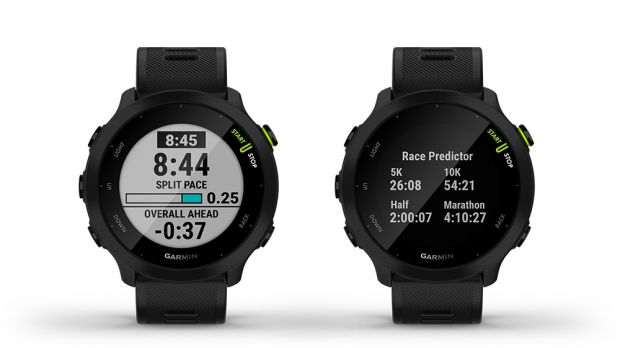
The new estimated finish time tool is an even simpler race option – you just select the distance you’re going to run and hit start on the watch. You then get a dedicated data screen showing your average pace, distance remaining and an estimated finish time, which will keep updating if you speed up or slow down.
The Forerunner 55 is the same size as the 45, with a 1.04in (26.3mm), 208x208 transflective screen that’s clear to read in all conditions, including bright sunlight, and five buttons to make it easy to navigate the menus. The screen is smaller than that on most other Garmins and indeed the Coros Pace 2, and although I didn’t have trouble reading it on the run, I do prefer something a little larger and clearer.
All the new features make the Forerunner 55 a very well-rounded running watch for under £200, but since many of them are software updates it would have been nice to see Garmin make some of them available on the Forerunner 45. As a dedicated running watch, the 45 should have access to Track Run mode in particular.
Using The Garmin Forerunner 55
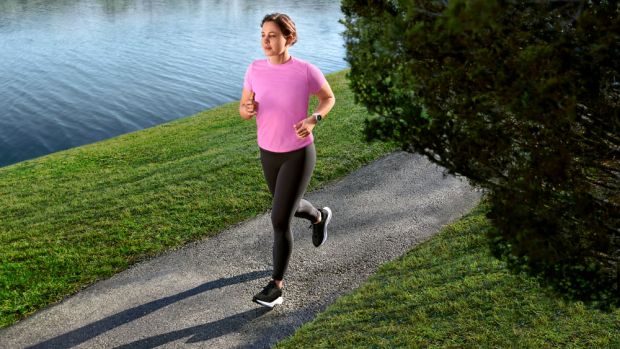
To test the Forerunner 55’s accuracy I wore it for a variety of workouts including a lot of indoor and outdoor running, bike rides and yoga. I also did strength sessions with it, but these have to be labelled as “other” because Garmin has not put its strength mode on the Forerunner 55, which is an irritating omission.
The heart rate tracking is exceptionally good for an optical wrist monitor, matching a chest strap’s readings pretty much beat for beat throughout my workouts. There was a small, unexpected spike during one run, but otherwise it’s been consistently accurate even when doing interval runs with quick ups and downs in heart rate.
I’d still be tempted to pair the Forerunner 55 with a chest strap for the most accurate readings possible, especially if you were planning on relying on the recovery advisor and doing heart rate-based workouts with the watch. But if you just want general heart rate info the watch’s sensors are more than good enough.
The GPS accuracy was occasionally questionable, seeming a tad generous compared with the readings from other watches on a few of my training runs, but generally the results were close enough. For the previously mentioned half marathon, a properly measured course, it logged 21.22km, which is probably spot-on given that I wasn’t following a perfect racing line throughout.
The watch took a long time to find a GPS fix the first time I used it, but since then it has been as fast as any other device in locking on, even when starting a run in a new location.
I’ve been impressed by the battery life. It lasts a week comfortably, even when I log around 80km of outdoor running. The Forerunner 45 tended to need charging every four or five days, while the 55 can reach seven to 10 days depending on your volume of training.
The Forerunner 55 still has all the features from the 45 of course, including structured workouts and VO2 max estimates, and it also has Garmin’s everyday activity and sleep tracking features: these include stress monitoring and Body Battery, which provides a rating of your energy levels at any time out of 100. It’s worth noting, however, that the watch doesn’t get Garmin’s sleep widget – you can see your data only in the Garmin Connect app.
Some features that appear on more expensive Garmin devices but are missing here include navigation, more detailed training analysis, a multisport mode and smart features like NFC payments. However, the Forerunner 55 does have access to the Connect IQ store, which offers a range of watch faces plus some useful third-party apps for accessories like the Stryd footpod.
There’s no doubt Garmin’s updates to the Forerunner 55 are useful (though I maintain some could have just gone on the Forerunner 45), or that it’s a cracking running watch that’s great for newer runners but will still serve more experienced people well.
See related
- The Best Running Watches Of 2021
- How To Buy The Best Garmin Fitness Tracker For You
- The Best Fitness Trackers Of 2021
Should You Buy The Garmin Forerunner 55 Or Something Else?
While it may be a great watch, the more pertinent question is how it matches up to the Coros Pace 2, which is also £180. The Pace 2 has more features, offering detailed training analysis, a longer battery life of 30 hours GPS, triathlon tracking, running power measured from the wrist and a barometric altimeter. The Pace 2 also has a bigger 1.2in (30.5mm) screen while still feeling just as small and light as the 55.
That’s a lot of pros for the Pace 2, but the Forerunner 55 still has its merits. The Coros doesn’t offer suggested workouts, and I find Garmin’s five-button design easier to use than Coros’s spinning wheel. Garmin’s user interface on the watch and in the app is also better for my money, though I wouldn’t call it a dealbreaker.
One thing worth noting is that while the two watches have the same RRP, devices in the Forerunner range often drop their prices after a few months, while Coros’s seem to stick to their RRP.
At £180, though, the Pace 2 simply offers more than the Forerunner 55 – and there’s also a case for choosing the Forerunner 45 ahead of the 55, since it’s often available for £120 and sometimes below £100. While you’d miss out on some useful features including impressive battery life, the 45 still fits the bill as a cheaper option that will meet the key needs of most runners.
Buy from Garmin | £179.99
Rating ⭐⭐⭐⭐ (4/5)

Nick Harris-Fry is a journalist who has been covering health and fitness since 2015. Nick is an avid runner, covering 70-110km a week, which gives him ample opportunity to test a wide range of running shoes and running gear. He is also the chief tester for fitness trackers and running watches, treadmills and exercise bikes, and workout headphones.
